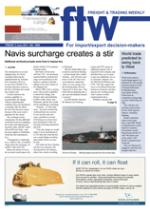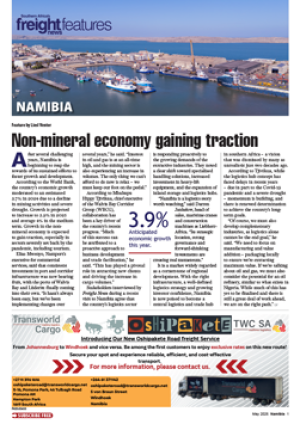The introduction by several
shipping lines of a Navis
surcharge following the
implementation by Transnet
Port Terminals (TPT) of
its new Navis SPARCS N4
terminal operation system at
the Port of Durban this month
has created a stir.
Carriers that have the
systems capability to
accommodate the change
without impacting their
workforce have not introduced
a surcharge. But for others
the Navis fee has been raised
because of the extra work it
generates for the carrier.
The surcharge merely
compensates for the additional
workload involved in updating
the system and capturing the
necessary data, said PIL South
Africa MD Ivan Naik – and
the same applies to NileDutch,
which has also introduced a
levy.
“Transparency is important
to us, which is why we notified
clients about the surcharge, set
at R80,” Naik told FTW.
Before the advent of Navis,
the terminal would capture the
details off the CTO (container
terminal order).
But Navis will do away
with the CTO – the document
required before containerised
cargo can be picked up at the
harbour container terminals –
adding to the work volume of
the shipping line.
Mitsui OSK Lines is among
those with systems capability
to absorb the change, and
director sales and marketing
at MOL South Africa, Iain
McIntosh, said the line would
not be introducing a surcharge.
“Transnet – as with many
areas – has been transferring
workload back into carriers.
In our case this does not
cause a problem as at time
of booking our systems have
been developed to allow for
this and increasing automation
and EDI.
“The only charge we would
make is for an amendment to
a CTO after the event but this
was a small charge we had in
place before Navis cut over,”
he said.
And while the Navis Durban
roll-out was a disaster well
documented by the industry,
delays have eased, according
to McIntosh.
“But the initial delays have
created an enormous backlog
– as these things have a habit
of doing – and will take some
time to work off. One of my
vessel planners stated that
where we were seeing a fiveday
berthing delay, this has
‘improved’ to three days. They
claim that the planning side is
up to par but landside remains
a concern.”
An EDI interface between
the Maersk Line booking
system and TPT means no
additional manual work is
required for the company and
therefore there was no need
to pass any additional cost on
to customers, Maersk Line
SA MD David Williams told
FTW. “We fully support the
move to an efficient electronic
business-to-business interface
and are also working closely
with Customs on their
modernisation drive.
Williams concedes that managing a change of this
magnitude is challenging.
“Only TPT can answer
the question as to whether
everything possible was done
to ensure the most efficient
and effective change. From my
personal experience, having
visited the port in mid-April, I
was encouraged by the handson
and direct on-the-ground
involvement of the senior
management I met.”
Safmarine, which will
also not be contemplating a
surcharge, reports weekly
improvements in port
productivity, after the initial
delays.
“Teething problems are to
be expected when introducing
any new IT system,” South
African national export
executive Janine Nainkin told
FTW, “and many of the initial
challenges experienced with
the implementation of Navis,
were related to user adaptation,
and have now been resolved.”
Navis surcharge creates a stir
03 Jun 2011 - by Joy Orlek
0 Comments
FTW - 3 Jun 11

03 Jun 2011
03 Jun 2011
03 Jun 2011
03 Jun 2011
03 Jun 2011
03 Jun 2011
03 Jun 2011
03 Jun 2011
03 Jun 2011
